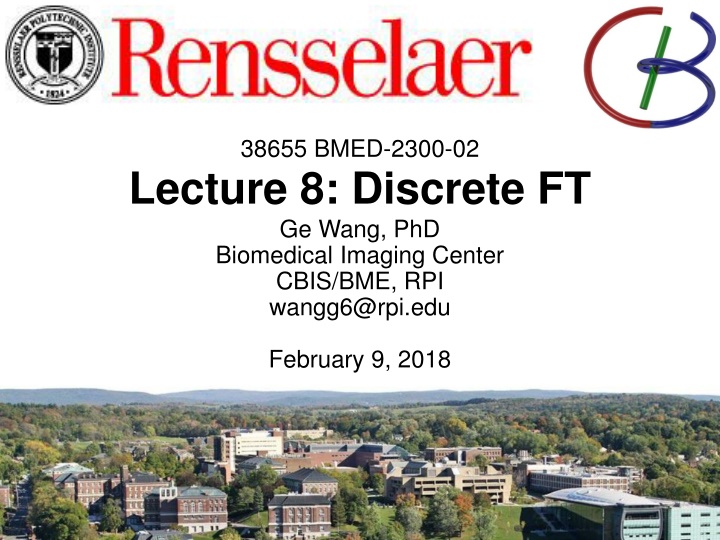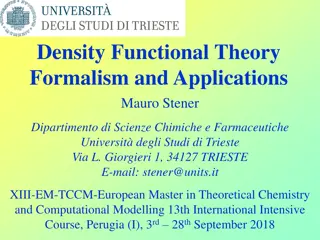
Understanding Signal Sampling and the Sampling Theorem
Explore the concepts of signal sampling, the Sampling Theorem, and spectral duplication in signal processing. Learn about Nyquist Theorem and the implications of aliasing in this comprehensive study.
Download Presentation

Please find below an Image/Link to download the presentation.
The content on the website is provided AS IS for your information and personal use only. It may not be sold, licensed, or shared on other websites without obtaining consent from the author. If you encounter any issues during the download, it is possible that the publisher has removed the file from their server.
You are allowed to download the files provided on this website for personal or commercial use, subject to the condition that they are used lawfully. All files are the property of their respective owners.
The content on the website is provided AS IS for your information and personal use only. It may not be sold, licensed, or shared on other websites without obtaining consent from the author.
E N D
Presentation Transcript
38655 BMED-2300-02 Lecture 8: Discrete FT Ge Wang, PhD Biomedical Imaging Center CBIS/BME, RPI wangg6@rpi.edu February 9, 2018
BB Schedule for S18 Tue 1/16 1/23 1/30 2/06 2/13 2/20 2/27 3/06 3/20 3/27 4/03 4/10 4/17 4/24 Topic Introduction System Fourier Series Signal Processing MatLab II (Homework) No Class Quality & Performance CT Reconstruction MatLab III (CT) PET & SPECT Exam II MRI III Ultrasound II Machine Learning Fri 1/19 1/26 2/02 2/09 2/16 2/23 3/02 3/09 3/23 3/30 4/06 4/13 4/20 4/27 Topic MatLab I (Basics) Convolution Fourier Transform Discrete FT & FFT Network Exam I X-ray & Radiography CT Scanner Nuclear Physics MRI I MRI II Ultrasound I Optical Imaging Exam III Office Hour: Ge Tue & Fri 3-4 @ CBIS 3209 | wangg6@rpi.edu Kathleen Mon 4-5 & Thurs 4-5 @ JEC 7045 | chens18@rpi.edu
Derivation of the Sampling Theorem https://dsp.stackexchange.com/questions/37480/formulating-a-function-on-matlab-for-the-shannon-interpolation-formula
Signal Sampling ( ) x f Continuous Signal x Shah Function (Impulse Train) ( ) s x ( ) ( ) x = x nT s = n x T Sampled Function ( ) x ( ) ( ) f x s x ( ) f x ( ) = = f x nT s = n
Spectral Duplication Sampled Function ( ) x ( ) ( ) f x s x ( ) f x ( ) = = f x nT s = n 1 T n T ( ) ( ) ( ) ( ) = = F u F u S u F u u S = n ( ) u ( ) u A FS F AT u u u u max max 1T Sampling Frequency 1 T There will be no overlap if u max 2
Nyquist Theorem 1 T ( ) u FS u If max 2 Aliasing u u max 1 T When can we recover F(u) from FS(u)? 1 T u Only if (Nyquist Frequency) max 2 We can use 12 T u ( ) T = C u Otherwise 0 ( ) x ( ) u ( ) u ( ) ( ) C u = = IFT f F F F u Then and S 2u Sampling frequency must be greater than max
From Continuous to Discrete g(t) f(t) G(t) F(t) Continuous Discrete
Big Picture 1 P = = / N T TP 1 T = = = / M N P PT
Key Variables 1 P = = / N T TP 1 T = = = / M N P PT 1 N 1 1 P T = = t u
Continuous FT of Sampled f(t) n n t u P ( ) f u 2 2 i i = n = n T ( ) f t c e c e n n = =
Sampling in the Fourier Domain 1 N 1 1 P T = = t u
Use of Integer Indices e e e e e e e e e [ ] f m = [ ] f n
Inverse Discrete Fourier Transform 1 e e e e e e e e e f m = [ ] f n [ ]
Discrete FT in Different Notations Vector of N Elements Only Needs N Basis Functions 1 N = 1 N ikn = 2 N H h e n k N Harmonic Orthogonal Basis Functions Are Enough 0 k 1 N = n Frequencies Differ by Constant Increment ikn = 2 N h H e k n 0 Forward & Inverse Transforms Are Symmetric
FFT Fast Fourier Transform (FFT) is an efficient algorithm for performing a discrete Fourier transform FFT published by Cooley & Tukey in 1965 In 1969, the 2048 point analysis of a seismic trace took 13 hours. Using the FFT, the same task on the same machine took 2.4 seconds!
Application 1: Discrete Convolution https://www.mathworks.com/matlabcentral/answers/38066-difference-between-conv-ifft-fft-when-doing-convolution
Application 2: Spectral Analysis Fs = 1e3; t = 0:0.001:1 0.001; x = cos(2*pi*100*t)+sin(2*pi*202.5*t); Plot(x(1:100)); https://www.mathworks.com/help/signal/ug/amplitude-estimation-and-zero-padding.html
Without Zero Padding xdft = fft(x); xdft = xdft(1:length(x)/2+1); xdft = xdft/length(x); xdft(2:500) = 2*xdft(2:500); freq = 0:Fs/length(x):Fs/2; plot(freq,abs(xdft)) hold on plot(freq,ones(length(x)/2+1,1),'LineWidth',2) xlabel('Hz') ylabel('Amplitude') hold off
Zero Padding xdft = fft(x,2000); xdft = xdft(1:length(xdft)/2+1); xdft = xdft/length(x); xdft(2:500) = 2*xdft(2:500); freq =0:Fs/(2*length(x)):Fs/2; plot(freq,abs(xdft)) hold on plot(freq,ones(2*length(x)/2+1,1),'LineWidth',2) xlabel('Hz') ylabel('Amplitude') hold off
Wheat & Chessboard Problem Exponential growth never can go on very long in a finite space with finite resources.
https://see.stanford.edu/Course/EE261 https://see.stanford.edu/materials/lsoftaee261/book-fall-07.pdf
https://see.stanford.edu/Course/EE261 https://see.stanford.edu/materials/lsoftaee261/book-fall-07.pdf
ArtX HW: Do an Overview Poster DFT & FFT Signal Processing Fourier Series Fourier Transform Periodic Non-periodic Convolution Shift-invariant Linear System Due Next Fri Function/System






















